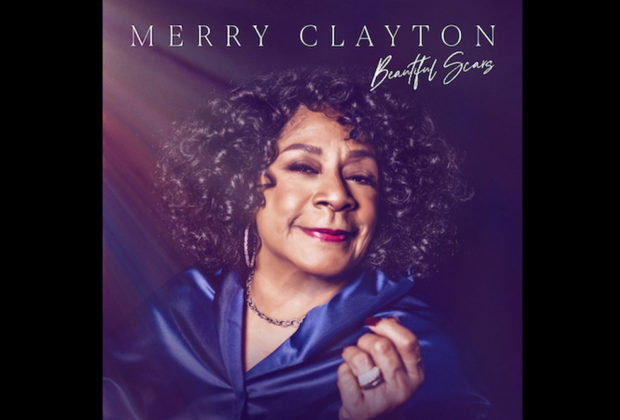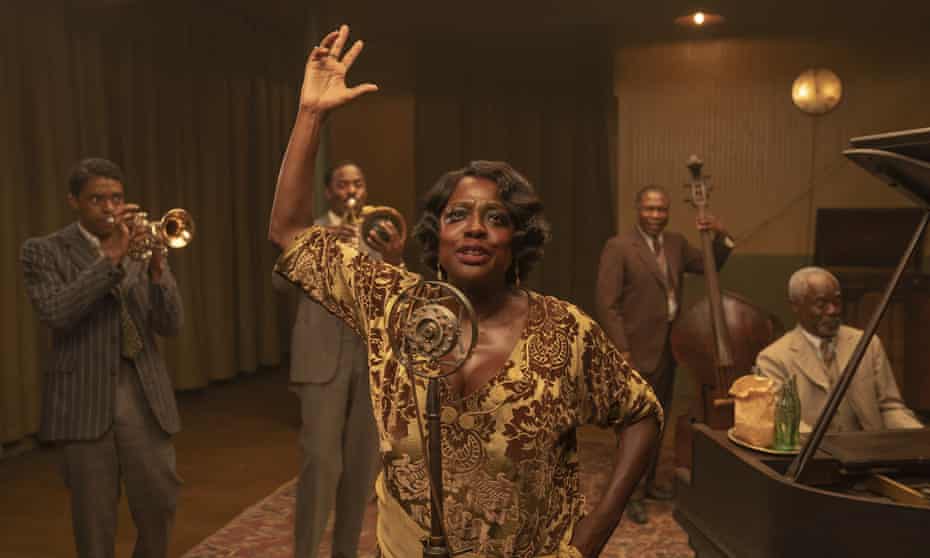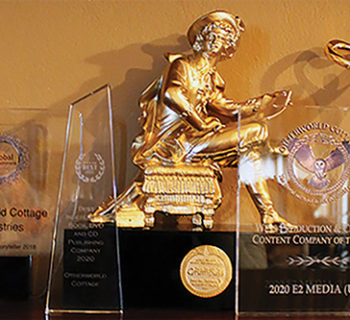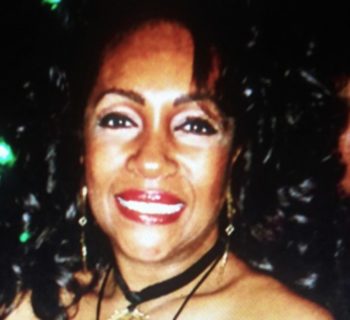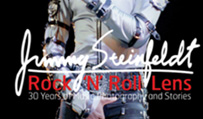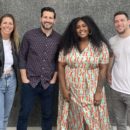One of the most acclaimed and recognizable voices of all time, Merry Clayton released her first album in over 25 years, Beautiful Scars, April 9 on Motown Gospel/Capitol Records.
Produced by longtime producer/songwriter/entrepreneur and Rock & Roll Hall of Fame inductee Lou Adler, the album features new compositions written by Chris Martin and Diane Warren and covers of classic songs by Sam Cooke, Leon Russell and more.
Compared to her previous albums, Beautiful Scars is a gospel-influenced project that brings her back to her roots as a church singer in her hometown of New Orleans.
While the inspiring music takes center stage, the story behind the album was one born in tragedy.
In 2014, mere months after 20 Feet From Stardom, the documentary in which she stars and won an Oscar - Merry was involved in a devastating car accident that claimed both of her legs and required a 5 month stay in the hospital. In a New York Times article chronicling her recovery, she stated “It’s not an easy task, but I am just so determined. If I was determined enough to make it out of that hospital alive and better, I can certainly forge straight ahead.”
Merry Clayton was born on Christmas Day and a graduate of Jefferson High School’s music department then under renowned instructor Sam Browne, in Los Angeles, California.
Before Clayton’s torrid vocal chores were paired to those of Mick Jagger on the Rolling Stones’ anthem “Gimme Shelter” from their epochal Let It Bleed album, Merry had already shared a microphone with Bobby Darin, Pearl Bailey, and was a member of the Ray Charles’ Raelettes from 1966-1968.
During her studio career she has sung backup on records with Elvis Presley, Joe Cocker, Phil Ochs, and Burt Bacharach. Clayton is one of the featured lead voices on a rendition of Bob Dylan’s “All Along the Watchtower,” off the stellar Dylan’s Gospel album Adler produced with the Brothers and Sisters studio collective.
Actually, Clayton’s formal introduction to the Rolling Stones began earlier in 1964 when the band along with their visionary manager/record producer, Andrew Loog Oldham first arrived in Hollywood.
The lads attended a Jack Nitzsche-produced session at the legendary RCA Recording studios where Clayton was tracking with Edna Wright, Darlene Love’s sister on the date. Andrew and the Stones were driven to RCA by Sonny Bono, then working for Phil Spector.
It was Oldham, then a fan of Nitzsche, who wanted to meet and see Jack in action. After he discovered the Rolling Stones, Andrew had produced a 1964 session with John Baldwin, (then quickly re-named John Paul Jones, before his Led Zeppelin career) on a re-make of Nitzsche’s “Baja,” the flip side of Jack’s 45RPM instrumental anthem, “The Lonely Surfer.”
“Sonny Bono took us for a ride to the RCA studios on Sunset in Hollywood. That afternoon I met three important elements in the Stones recording future: Jack Nitzsche, Dave Hassinger and the RCA studio itself,” offered Andrew Loog Oldham in his splendid 2Stoned autobiography.
“Jack gave us the understanding of tone. Which tone fits the universe? Which thing was hummable in the street? Jack Nitzsche had the ability to sit and to figure it out, to get to the square root of the sound.”
“I met the Stones in 1964,” Nitzsche told me in a 1988 interview.
“Andrew Loog Oldham called me up. He and the group had just met Phil Spector in England and wanted to meet me. Brian Jones was in a three-piece suit and tie. The saw me work with Edna and Merry Clayton at RCA. A little later, the Stones started working at RCA and it had a big impact on me and a whole new way of approaching records.
“I was used to a three-hour record date, and they were block-booking twenty-four hours a day for two weeks, and doing what they wanted. I liked going to the Hollywood Ranch market with Keith (Richards) when he was in town. I later went to England to see the film Performance when Mick (Jagger) came to me about doing the soundtrack when they were doing Let It Bleed. When I was in London, the apartment they got me was right around the corner from where Keith was living with Anita (Pallenberg).”
Mick and Keith along with producer Jimmy Miller in July of 1968 had mixed the Stones’ influential Beggar’s Banquet album at the Hollywood -based Sunset Sound recording facility on Sunset Blvd.
In 1969, the Stones had already prepared the basic rhythm track for “Gimme Shelter” in England at the famed Olympic Studios with engineer George Chkiantz. Later in ’69, Keith and Mick returned to the same Elektra Studios with engineer Bruce Botnick, well known for his technical talents behind the dials on albums with Love, Buffalo Springfield and the Doors.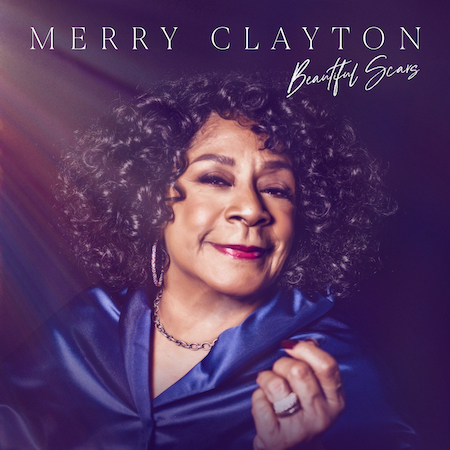
“First of all, Glynn Johns did all of the recording,” Botnick mentioned in a 2009 interview we did. “I facilitated and worked as a second engineer to get him through the night. Glynn did a great job. And he was under a lot of pressure with them. The first playback of ‘Gimme Shelter’ was incredible…On the Let It Bleed album I made suggestions and brought in the country music fiddle player Byron Berline for ‘Country Honk.’”
“Gimme Shelter” songwriters Mick and Keith along with Jimmy then huddled during their October 18th -27th Southern California visit just before the Stones embarked on their US tour in November ’69.
Nitzsche, an omnipresent figure and regular Stones’ session collaborator on over a half a dozen previous Stones LP’s felt that a female singer should join Jagger on the lead vocal for “Gimme Shelter.”
Initially, Mick, Keith and Jimmy had intended to utilize Bonnie Bramlett of Delaney & Bonnie, but she wasn’t available, possibly due to illness or contract availability restrictions.
Nitzsche then suggested Clayton for the slot to augment the hypnotic and weaving guitar efforts of Keith, who sang on the recording as well, along with the propulsive contributions from drummer Charlie Watts, bassist Bill Wyman and Nicky Hopkins on piano.
“Jack called me at home from the studio in the Los Angeles area one night where I lived with my husband, Curtis Amy,” recalled the still awe-inspiring Clayton in a 2008 telephone interview we conducted. (Amy was a legendary jazz musician himself, known for his classic album with Dupree Bolton, Katanga! In 1968, Curtis took the sax solo on the Doors’ hit “Touch Me.”)
“Jack called our home and Curtis told him I was just about ready to go to sleep. See, I was pregnant, but Jack insisted that he had to talk to me about this Stones’ session immediately as I was about to go to sleep. Curtis then woke me up. Jack was on the line. ‘Merry, I really need you to do this part. There is no other singer who can do this. Please.’
“I always loved Jack, like Lou Adler, he always took a chance on me, and I worked with Jack on the Performance soundtrack he did and I had worked with Jack earlier on a record he did with Neil Young in 1968 or ‘69. “OK… I was really tired that night, but I got up, put on my coat, got in the car with Curtis and we drove up La Cienega from LA to Hollywood later that evening where the studio was located.”
When she arrived, Clayton was warmly greeted by Keith, and then checked out Jagger in the flesh.
“Man, I thought you was a man, but you nothing but a skinny little boy!’ They played me the song and asked if I could put a little somethin’ on it…I said ‘stop the song and tell me what all this stuff meant before I went any further. It’s just a shout or shot away’ was something in the lyrics.’
“I said, ‘I’m gonna put my vocal on it and I’m gonna leave. ‘Cause this is a real high part and I will be wettin’ myself if I sing any higher!’ ‘Cause my stomach was a little bit heavy…
“So, we went in and did it. Matter of fact, I did it three times. I didn’t do an overdub. Mick’s vocal was already on it when I heard it and I recall he did a bit of touching up after I left. But they got what they wanted. ‘It was so nice meeting you guys.’ ‘Oh Merry you sound incredible. We just love you. We’re gonna work with you…’ I was walkin’ out the door as they were talkin’. ‘OK. ‘Love you guys, too! See you some other time.’ And I got in the car with my husband who took me right home and I went right upstairs to bed. And that was the ‘Gimme Shelter’ session.”
Hearing Clayton’s voice along with Jagger on the “Gimme Shelter” recording, Merry Clayton is both audio witness and temptation partner. Miller played percussion on the session and Jagger inserted his own piercing harmonica overdubbed metallic comment on “Gimme Shelter.”
Just before her vocal chores were recorded that evening, Clayton, no rookie in the music business, had politely voiced some traditional concerns about payment procedure and credit for her work that night. Very swiftly the Stones’s legal team generated recording agreement paperwork that now requested her coveted autograph for the booking.
“Next thing I knew, lawyers had talked and everything was cool. And, it was a go on the record. Then immediately I heard it on the radio in Los Angeles. It’s a powerful track,” admitted Merry.
“My dad, who was a Bishop, heard it and said, ‘Merry, what is this line in the song about rape and the murder?’ ‘Well dad, that’s part of the song.’ And he laughed…
‘Boy, they’re really singing them different these days.’ Cause I call him Reverend Doctor Daddy. ‘You know they’re singing them different these days and that’s what it is.’ “Well you know, just remember one thing, Remember as you go out there on the road and travel on the road with the Rollin’ Cockers, ‘cause I worked with Joe Cocker, too, so he could never get the names together. ‘Just remember when you are out there with the Rollin’ Cockers daddy is prayin’ for you.’ ‘Oh daddy, I need that so bad. Thank you so much.’ ‘And do it while you’re young ‘cause when you get older you’re not going to run up and down the road.’ My father always encouraged me to do things with class, dignity and integrity,” reinforced Clayton.
“Gimme Shelter” debuted on that Rolling Stones’ ’69 US trek. I recall hearing the song on stage before the Let It Bleed LP was shipped to retail outlets at the November 8th Stones concert at the Inglewood Forum venue. I went to both shows that long night of November 8th and 9th.
I sat with my pal Bob Sherman from West Los Angeles College. I remember the initial public airing of “Gimme Shelter” was spooky. 50 years later on vinyl. CD, digital download format, and in the Rolling Stones’ most recent shows, it still sounds…spooky.
“In a way, maybe when you write songs without even knowing it, you’re kinda saying, ‘can I do this live?’ And so in a way you add that in,” Keith Richards told me in a backstage interview in 1999 conducted for HITS magazine at a Stones’ gig in San Diego, CA.
“And so in a way you add that in. You don’t know if it’s gonna work, but I guess what you keep in the back of your mind is, ‘We’re making a record here; what happens if they all like it and we gotta play it live?’ So, in a way, maybe in the back of the mind that sets up the song to be playable on stage,” ventured Keith.
Subsequently, Lou Adler produced a version of “Gimme Shelter” with Clayton herself in 1970 for his Ode Records label. In 1972 I saw Merry mesmerize a college crowd singing this monumental copyright at San Diego State University when I was a student.
“Gimme Shelter” also served as the same title of the 1969 Stones’ US tour documentary.
Subsequently, over the last 50 years the ABKCO master tape recording of “Gimme Shelter” has also been broadcast in many feature films: Adventures in Babysitting, Air America, GoodFellas, and Casino.
“Definitely the greatest backing vocal of all time - still remember hearing it in '72 on the car radio in my brother's 65 Mustang and a guy named Alex Hajdu in the front seat yelling, ‘That's Merry Clayton!’ when the chorus kicked in. It made such an impression on me cause I'd never heard anyone single out a backup singer before,” volunteered film and television producer and director Michael Hacker.
In 1971 Clayton sang some backgrounds vocals on Lou Adler’s production of the Carole King landmark album Tapestry.
In 2008 I wrote the liner notes on Adler’s invitation for the deluxe edition reissue of Tapestry for the Sony/Legacy/Ode label. That year I asked Merry about participating on Carole King’s Tapestry recording sessions.
“I remember I was at about to take a girlfriend out to dinner because it was her birthday. I told her I had to go by the A&M Recording studio to go say hi to my husband (Curtis Amy) and Lou,” described Clayton from her longtime home in downtown L.A.
“I walk into that big main hallway and here comes Carole King. ‘Merry! Come in. You gotta do this song with me. You gotta do this one little part on this song for me.’ I walked in the studio and I will never forget her hanging over the piano writing musical notes.
“And she played me the track for ‘Way Over Yonder.’ “Wow! I want that song.’ But she told me it was for her album. And I did my part. The song was so fabulous and so churchy to me. So what I love and so what I love doing. And I walked in and nailed it. And Lou and Hank Cicalo the engineer were in the vocal studio C. I was walking down the hallway to leave and I heard it and came all the way back. Oh honey. I was standing next to Carole holding her arm and said, ‘Oh Carole, this is just so good.’
“I was on a few other songs. ‘You’ve Got A Friend,’ ‘Smackwater Jack,’ and ‘Where You Lead’ that I did background vocals on with Carole and Julia Tillman.
“Carole King had church in her vocals. You know why? Because she was around church, honey. Carole was around soulful beautiful people. When you surround yourself with soulful beautiful people can nothing come out of you but soulfulness. And beauty and she surrounded herself with that.
“See, Lou and Curtis were like brothers,” added Merry, “and Curtis was coming from jazz, which was cool. As far as Curtis was concerned Lou was his brother. It was a bond between those two that I even saw in Curtis’ death,” she revealed.
“When Lou came to the hospital by his bedside. They talked about stuff that I didn’t even know they were talkin’ about. By his bedside as Curtis was leaving this earth. Lou was there. They had a bond they had created over the years. Very special. You don’t see that very often between two men,” suggested Merry.
“Ray Charles was another one like Lou who came to see Curtis in the hospital. Ray called me. ‘Sister Mary? This is the old man, Brother Ray.’ ‘Yes. Hey Papa, how you doin’?’ ‘The question is daughter, how you doin’?’ ‘Well…I’m not doin’ too good,,,.’ ‘So I told him.’ ‘Oh shit. I’ll be there tomorrow. Tell the doctors I want a conference when I get there.’
“I called the doctors and they were standing at attention when he arrived with Joe Adams when they walked through that door. Curtis looked up and said, ‘Ray! I must be sick. Brother Ray is here!’ (laughs).
“Honey, Tapestry was an anointed project,” stressed Clayton. It had God all over it as far as I was concerned, because I could feel it. You know, when you feel stuff. You can feel that music and you can get a little tingle from the back of your neck and up my back. It had magic. It was absolutely magic,” marveled Mary.
Harvey Kubernik is the author of 19 books, including This Is Rebel Music, Canyon Of Dreams: The Magic And The Music Of Laurel Canyon and Turn Up The Radio! Rock, Pop and Roll In Los Angeles 1956-1972. Sterling/Barnes and Noble in 2018 published Harvey and Kenneth Kubernik’s The Story Of The Band: From Big Pink To The Last Waltz. For October 2021 the duo has written a multi-narrative volume on Jimi Hendrix for Sterling/Barnes and Noble.
Otherworld Cottage Industries in 2020 published Harvey’s book, Docs That Rock, Music That Matters, featuring interviews with D.A. Pennebaker, Chris Hegedus, Albert Maysles, Murray Lerner, Morgan Neville, Dr. James Cushing, Curtis Hanson, Michael Lindsay-Hogg, Andrew Loog Oldham, Dick Clark, Ray Manzarek, John Densmore, Robby Krieger, Travis Pike, Allan Arkush, and David Leaf, among others.
This century Kubernik wrote the liner note booklets to the CD re-releases of Carole King’s Tapestry, Allen Ginsberg’s Kaddish, Elvis Presley The ’68 Comeback Special and The Ramones’ End of the Century). Harvey and Andrew Loog Oldham wrote the liner essays to The Essential Carole King.
Kubernik’s writings are in several book anthologies, The Rolling Stone Book Of The Beats and Drinking With Bukowski. Harvey penned a back cover endorsement for Michael Posner’s book on Leonard Cohen that Simon & Schuster, Canada published in October 2020, Leonard Cohen, Untold Stories: The Early Years.
During 2020 Harvey Kubernik served as a Consultant on the 2-part documentary Laurel Canyon: A Place in Time directed by Alison Ellwood. Kubernik is currently working on a documentary about Rock and Roll Hall of Fame member singer/songwriter Del Shannon.
Kubernik was interviewed last decade by director/producer Neil Norman for his GNP Crescendo documentary, The Seeds: Pushin’ Too Hard. Jan Savage and Daryl Hooper original members of the Seeds participated along with Bruce Johnston of the Beach Boys, Iggy Pop, Kim Fowley, Jim Salzer, the Bangles, photographer Ed Caraeff, Mark Weitz of the Strawberry Alarm Clock and Johnny Echols of Love. Miss Pamela Des Barres supplied the narration. Debut broadcast on television will be in 2021.
This decade Harvey was filmed for the currently in-production documentary about former Hollywood landmark Gold Star Recording Studio and co-owner/engineer Stan Ross produced and directed by Brad Ross and Jonathan Rosenberg. Brian Wilson, Herb Alpert, Richie Furay, Darlene Love, Mike Curb, Chris Montez, Bill Medley, Don Randi, Hal Blaine, Shel Talmy, Richard Sherman, Don Peake, Kim Fowley, Johnny Echols, Gloria Jones, Carol Kaye, Marky Ramone, David Kessel and Steven Van Zandt have been lensed.

